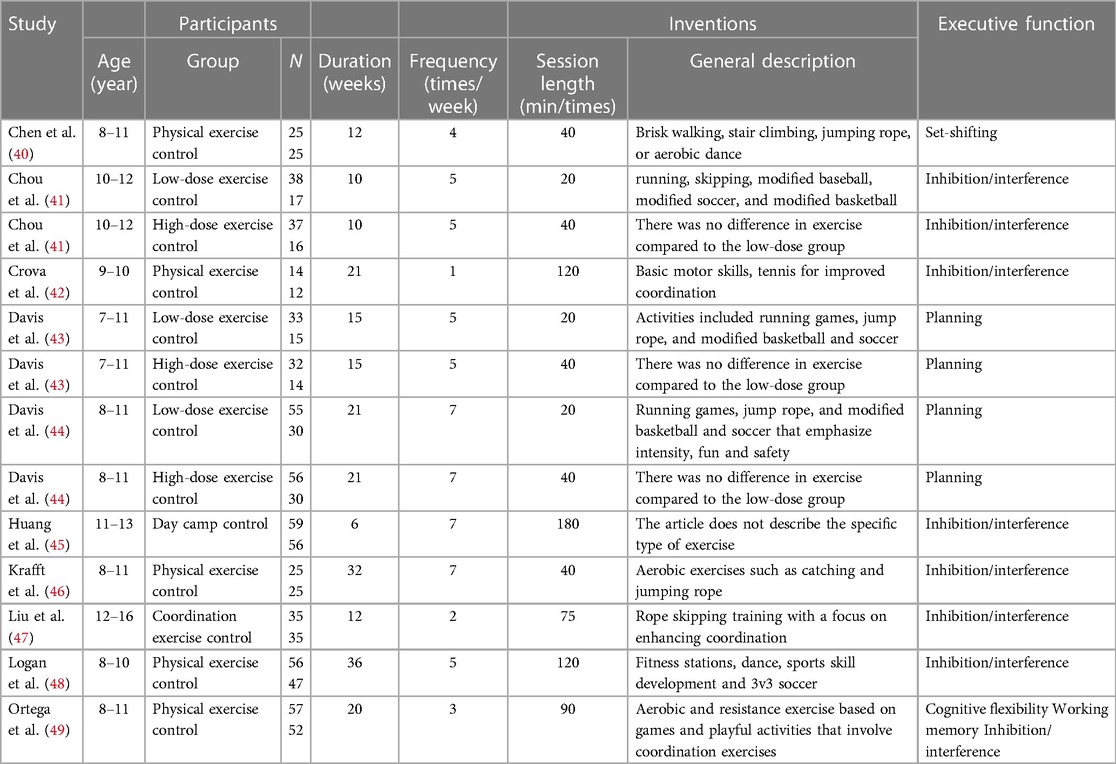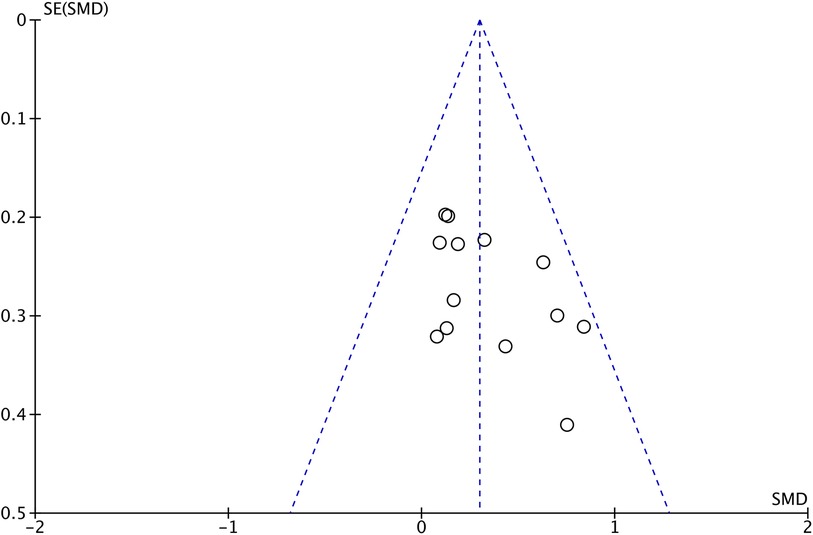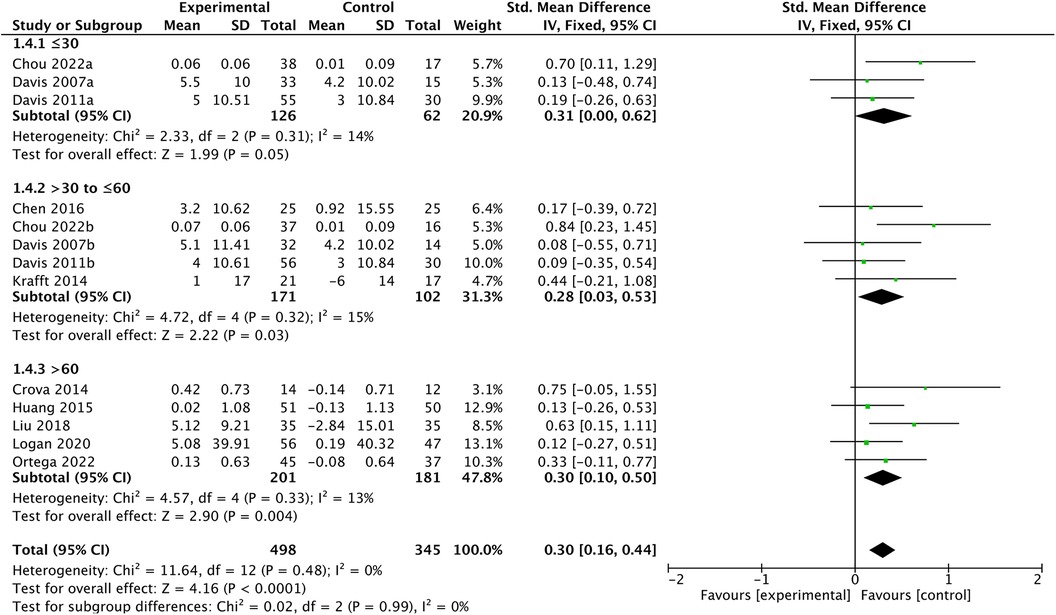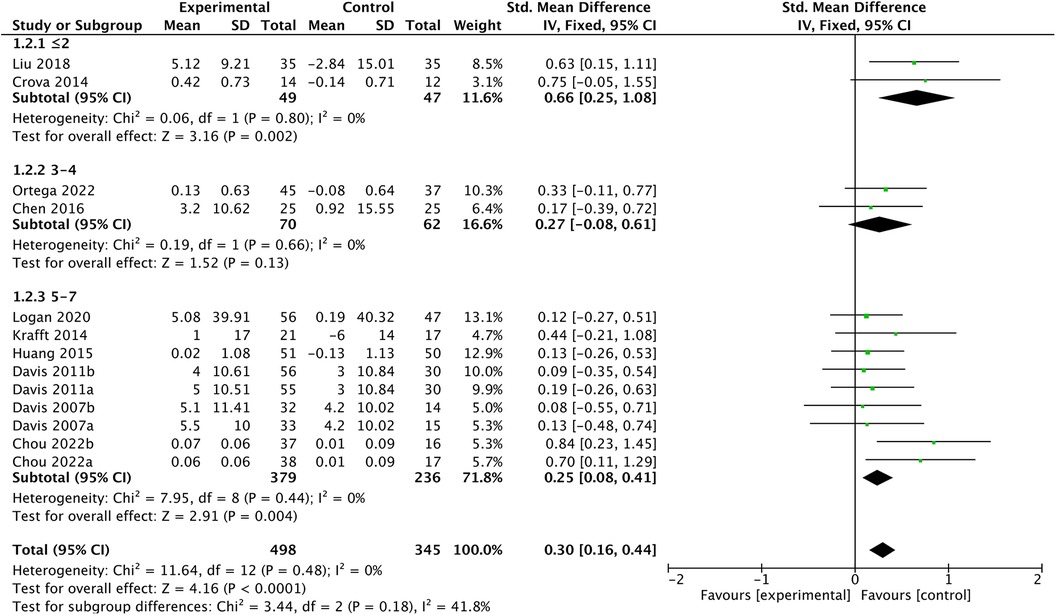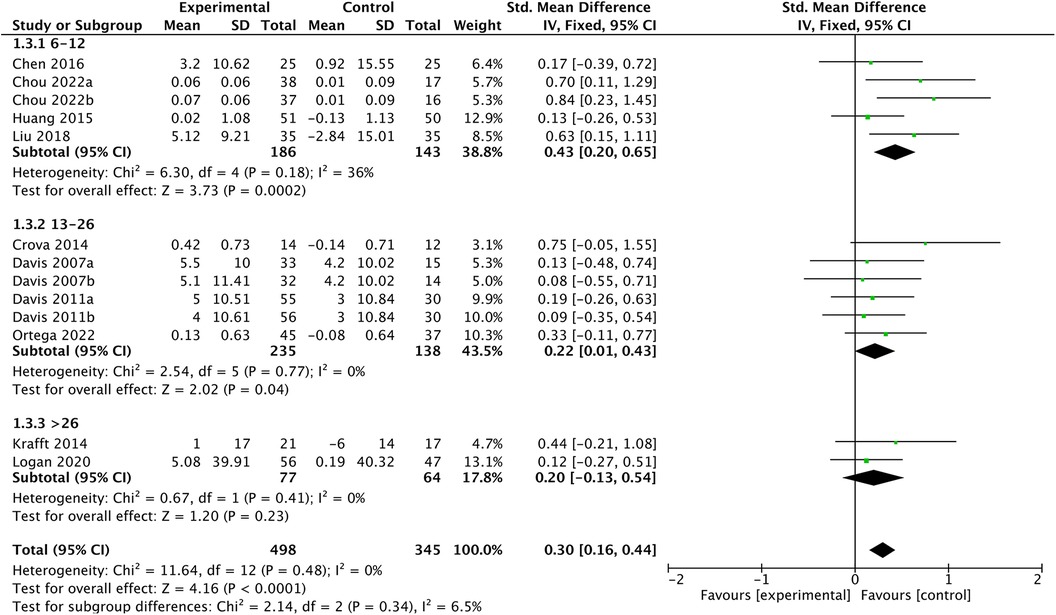- Faculty of Sports Science, Ningbo University, Ningbo, China
Objectives: To systematically evaluate the effectiveness of chronic exercise in physical activity (PA) as an intervention for executive functions (EFs) in children.
Methods: We conducted a systematic search in the following online databases: Web of Science, Cochrane Library, PubMed, Embase, and EBSCOhost. The timing is from database inception to July 2023, following PRISMA guidelines. Our inclusion criteria required studies reporting executive function (EF) levels in overweight children (age 0–18 years) before and after interventions. The Cochrane risk of bias tool assessed study bias, and Egger's test examined publication bias. Subgroup analyses considered three moderators: intervention duration, weekly frequency, and session length.
Results: The meta-analysis included a total of 10 studies with 843 participants. It revealed a statistically significant yet relatively small overall positive effect (g = 0.3, 95% CI 0.16–0.44, P < 0.01) of chronic exercise on EF in overweight children. Importantly, there was no significant heterogeneity (Q = 11.64, df = 12, P = 0.48; I2 = 0).
Conclusions: Chronic exercise interventions had a consistent positive impact on EF, irrespective of intervention duration, weekly frequency, or session length. However, given limitations in the number and design of studies, further high-quality research is needed to strengthen these conclusions.
Systematic Review Registration: PROSPERO identifier (CRD42023468588).
1 Introduction
Physical exercise holds significant benefits for people's physical health, compared to physical activity (PA), physical exercise typically refers to more planned and purposeful bodily activities (1). It functions as a proactive strategy against a diverse array of illnesses and possesses the potential to yield therapeutic outcomes for ailments (2, 3). The physiological benefits of physical exercise encompass various advantages, particularly in relation to brain development and function, where aerobic exercise has been found to be particularly beneficial, it can bring about alterations in the frontotemporal circuits, ultimately enhancing memory (4, 5). Physical exercise can be classified into two primary categories: acute exercise and chronic exercise. Chronic exercise refers to the consistent engagement in physical exercise for a prolonged period (surpassing six weeks or spanning several years). Chronic exercise is primarily intended to improve physical fitness, performance, or health (6). Cognitive functions cover a range of cognitive activities and processes that are done by the brain through the central nervous system. These functions include memory, attention, and reasoning (7). Studies have consistently found that engaging in PA improves the cognitive function of the elderly (8, 9). It is worth noting that chronic exercise functions as a protective element against the deterioration of cognitive function (10). PA enhances the interaction and expression of key neurotrophic factors in both central and peripheral tissues, including vascular endothelial growth factor (VEGF), brain-derived neurotrophic factor (BDNF), and insulin-like growth factor-1 (IGF-1). which in the end, positively impacts cognitive function and the plasticity of nerves and the brain (11).
Executive function (EF), also referred to as executive control, encompasses a multifaceted array of neurocognitive psychological mechanisms implicated in the regulation of purposeful actions, strategic planning, and ongoing evaluation (12). EF is a complex cognitive process that enables humans to focus their attention, develop strategies, and initiate actions (13). The developmental phase of childhood assumes significant importance in the formation of executive functions (EFs), as the cognitive-related cortex of the brain experiences fast growth during this era, which continues throughout adolescence (14). Therefore, it is crucial to emphasize the advancement of EFs during the stages of childhood and adolescence. Simultaneously, efforts should be made to prevent EF deficits in overweight children (15). Studies have provided evidence suggesting that children who are overweight have a notably inferior EF in comparison to their classmates who have a normal weight (16). Moreover, those who are substantially obese tend to display considerably weaker cognitive functions and abstract reasoning abilities (17). The association between overweight and EFs has a reciprocal nature, whereby children experiencing deficiencies in EFs are at an elevated susceptibility to obesity. The ramifications of obesity extend beyond the scope of these findings (18). A study from Thailand has revealed a connection between being overweight and experiencing subpar academic performance (19). Furthermore, overweight adolescents face a higher risk of anxiety disorders and depression compared to their normal-weight counterparts (20, 21).
Although statistical assessments indicate a recent deceleration in the upward trajectory of obesity rates, the prevalence of overweight youngsters continues to be a matter of apprehension (22). Hence, it is imperative to address the EF deficits observed in overweight children, and physical exercise is suggested as a strategy to improve their EF abilities. Physical exercise is of utmost importance for children who are overweight, as it not only contributes to enhancing their physical well-being but also plays a substantial part in the cognitive development and acquisition of learning abilities (23). There is a growing number of studies indicating that children benefit cognitively from chronic exercise (24–26). Given the expanding corpus of studies examining the connections between physical exercise and EF (27, 28), it becomes apparent that physical exercise can serve as a valuable intervention for overweight children, facilitating the improvement and enhancement of their EFs.
Currently, the predominant focus of EF research is on the adults (29–31). There is relatively limited research on children, particularly those who are overweight. There is a limited availability of articles that explicitly investigate EFs in children who are overweight. Therefore, this study proposes the use of meta-analysis as a quantitative methodology to further examine the effects of continuous exercise on the EFs of overweight children. In order to ascertain the potential differential impacts of chronic exercise on several sub-domains of EFs, we have classified EF into many sub-domains, including inhibition/interference control, working memory, set-shifting, cognitive flexibility, contextual memory, and planning (32).
2 Methods
2.1 Protocol and registration
This meta-analysis was conducted following the guidelines outlined in the Preferred Reporting Items for Systematic Reviews and Meta-Analyses (PRISMA) statement and the Cochrane Collaboration Handbook. Moreover, this study adhered to a pre-specified protocol (PROSPERO registration number: CRD42023468588).
2.2 Search strategy
The article was searched using five databases: Web of Science, Cochrane Library, Pubmed, Embase, and EBSCOhost, with the search period spanning from the inception of the databases to July 2023. The search strategy involved combining keywords such as “exercise,” “physical activity,” “executive function,” “children,” “adolescents,” and “over-weight,” and their synonyms to target relevant studies. Based on this search method, a search was conducted using free words and Medical Subject Headings (MeSH). The specific search methods vary among different websites, and the specific search methods for each website can be found in the Appendix.
2.3 Criteria for inclusion and exclusion
Articles that meet the following criteria will be included: (1) Participants are overweight (≥85th percentile body mass index for age and sex) (33) children (age 0–18 years) (34); (2) Physical exercise interventions will be used, with a duration ≥6 weeks (6); (3) The outcome indicators were tested using EF tasks; (4) The research type is randomized controlled trial (RCT) research; (5) Published in peer-reviewed journals and written in English or Chinese.
When the article contains the following content, it will be excluded: (1) Studies simultaneously implementing interventions other than physical exercise. (2) The EF test used only includes subjective scales, such as the BRIEF scale.
2.4 Data extraction
Studies were reviewed by two researchers (Chenxin Lin and Xiaying Wang), who independently retrieved data using a predetermined form. In cases where differences in opinions arose, a third researcher (Danyi Li), provided judgments. The extraction included study characteristics (author's name, year of publication), participant characteristics (age, sample size), interventions (Physical exercise style, duration, frequency, session length), and outcome indicators (EF sub-domain, results of measurements). When extracting outcome indicators, use the format of mean ± standard deviation to extract the pre-posttest changes for each study. When articles did not explicitly report change values, we retrieved the number of participants, baseline data, and post-test data from the relevant sections and then converted them in accordance with the standards set by the Cochrane Collaboration guidelines.
2.5 Risk of bias
Two researchers (Chenxin Lin and Xiaying Wang) independently reviewed the literature and extracted data according to a pre-designed table. In cases of disagreement between the two reviewers regarding data extraction, a third researcher (Danyi Li) was consulted for resolution. The assessment tool used was the Cochrane Collaboration guidelines (35).
2.6 Statistical analysis
Data were statistically analyzed using Review Manager 5.4 (Britain, Cochrane) and Stata 14.0 MP software (America, StataCorp LLC). In this study, we tested for heterogeneity based on the Q statistic and the I2 index (36, 37). When the P > 0.1 and I2 ≤ 50%, we consider the heterogeneity among studies to be acceptable and opt for a fixed-effects model to combine the results; when the P ≤ 0.1 and I2 > 50%, we consider the heterogeneity among studies to be significant, and we opt for a random-effects model to combine the results, thereby broadening the representation of larger sample sizes. In interpreting the results, we discussed the outcomes of the heterogeneity tests. If heterogeneity was observed, additional inquiry was undertaken to ascertain the origins of heterogeneity, hence ensuring the reliability and precision of the findings. To assess potential variations in the impact of physical exercise, subgroup moderation analyses were conducted, wherein the subgroup was adjusted and categorized based on prior research. These analyses aimed to investigate if the effects of physical exercise vary based on factors such as the length of intervention, weekly frequency, and duration of each session (38, 39). Publication bias was assessed through visual inspection of funnel plot asymmetry and statistically evaluated using Egger's test. (Bias in meta-analysis detected by a simple, graphical test.).
3 Results
The results are shown in Figure 1 which illustrates the article selection process. Initially, a total of 2,475 articles were identified through database searches. After removing duplicate references using EndNote 20 software (Canada, Onex Corporation) and manual screening, 887 duplicate articles were excluded. Subsequently, a review of titles and abstracts identified 97 articles that met the criteria for full-text review. Following the full-text screening, 12 articles were retained after eliminating those that did not meet the eligibility criteria. Ultimately, 10 articles were included in the meta-analysis after data extraction, with two articles excluded due to unavailability of data.
3.1 Research features
Within the compilation of 10 research, three of them used a design consisting of two experimental groups and one control group. Since the two experimental groups had different intervention durations, they were treated as two separate independent studies for data analysis. The control group size was evenly allocated to the two experimental groups, and specific details are shown in Table 1. To summarize, the studies included in this analysis focused on overweight children between the ages of 7 and 16. The number of participants in each study varied, ranging from 26 to 171. The duration of interventions exhibited variability, ranging from a minimum of 6 weeks to a high of 32 weeks. Intervention frequencies also differed, with the lowest being once a week and the highest being seven times a week. The shortest duration of each intervention session was 20 min, while the longest was 180 min. These assessments covered various sub-domains of EFs, including switching, inhibition, planning, cognitive flexibility, and working memory.
3.2 Risk of bias results
This review assessed the risk of bias in 10 articles, as shown in Figure 2. Out of the 10 papers examined, 1 article exhibited an indeterminate level of risk in relation to the random sequence generation, while the remaining articles were deemed to possess a low risk in this aspect. 2 papers were found to have insufficient explanations of allocation concealment, while 1 article failed to apply allocation concealment. Blinding of participants and employees was implemented in just two studies, while 3 articles did not incorporate blinding and the blinding status of 5 articles remains uncertain. When it comes to outcome evaluation, 5 articles adopted blinding, 3 did not, and 2 had an unknown status. Out of the ten publications examined, 9 of them exhibited comprehensive reporting of their findings, whilst 1 article had inadequate reporting. In relation to the issue of selective reporting and other biases, it was determined that all articles under consideration exhibited a low risk of bias.
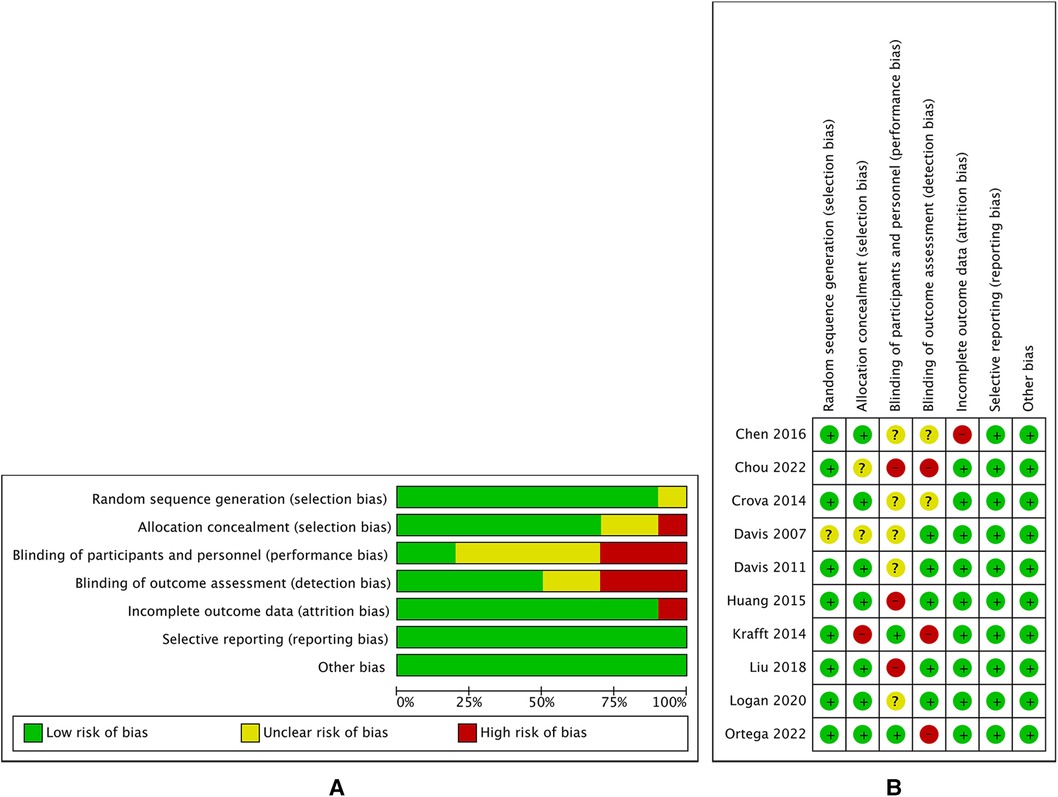
Figure 2. The result of the risk of bias assessment. (A) Risk of bias summary; (B) Risk of bias graph.
3.3 Effects of chronic exercise on EFs
The results of the meta-analysis, as shown in Figure 3, indicate a relatively small but statistically significant and positive overall effect size (g = 0.3, 95% CI 0.16–0.44, P < 0.01). This means that chronic exercise interventions can promote the improvement of executive function in children to a certain extent. In addition, no significant heterogeneity was observed (Q = 11.64, df = 12, P = 0.48; I2 = 0), meaning that the included articles had a high degree of homogeneity. The funnel plot, displayed in Figure 4, along with the Egger test (t = 2.10, df = 12, P = 0.06), and visual interpretation of the funnel plot, collectively suggest the absence of significant publication bias.
3.4 Subgroup analysis
In the subgroup analysis, the impact of chronic exercise on EFs appears to be consistent across varying study characteristics, please refer to Figures 5–7 for details. There is no significant influence of study duration (Q = 2.14, P = 0.34), weekly frequency (Q = 3.44, P = 0.18), or session length (Q = 0.02, P = 0.99) on EFs. Heterogeneity is minimal when study durations are in the range of 6–12 weeks (I2 = 36, P = 0.18), and it becomes extremely low for study durations of 13–26 weeks and over 26 weeks (I2 = 0, P = 0.77; I2 = 0, P = 0.41). Similarly, intervention frequency shows minimal heterogeneity for all categories, including ≤2, 3–4, and 5–7 times per week respectively (I2 = 0, P = 0.8; I2 = 0, P = 0.66; I2 = 0, P = 0.44). When session length falls within the categories of ≤30, >30–≤60, and >60, there is consistently low heterogeneity respectively (I2 = 14, P = 0.31; I2 = 15, P = 0.32; I2 = 13, P = 0.33).
4 Discussion
This review focuses solely on RCT, with the objective of thoroughly examining the effects of chronic exercise programs on EFs in children who are overweight. Our findings indicate that chronic exercise interventions have a modest yet statistically significant effect on overall EFs. Furthermore, as seen by subgroup analyses, the collective EF does not appear to be affected by the categorization of research according to factors such as study duration, intervention frequency, or session length. This suggests that the impact of chronic exercise on EFs in overweight children remains consistent, irrespective of most intervention features. However, it's worth noting that when these studies are grouped according to their duration, with studies lasting 26 weeks or more or interventions conducted three to four times per week, the effect sizes are no longer statistically significant. Further discussion is required about the relationship between the qualities of interventions and their impact sizes.
By examining the impact of chronic exercise interventions on EFs in overweight children through the lens of RCT, our meta-analysis underscores the stability of this relationship. While the overall impacts of various intervention features are consistent, the contrasting outcomes noted in specific subgroups underscore the necessity for a more comprehensive comprehension of the relationship between intervention characteristics and their effects on EFs.
The results of a 2019 meta-analysis are supported by our results (50), which also confirm the minimal effect size of chronic exercise on overall EFs. However, it's important to note that our findings are distinct in its specific focus on overweight children, making it a more targeted investigation. Additionally, this research considers a number of moderating factors, such as age, body mass index (BMI) percentiles, session length, and different exercise modalities, and it finds that intervention strategies and program duration significantly reduce the effects of chronic exercise on EFs (50). Another review article investigated the effects of acute and chronic physical exercise on EFs in children. In contrast to our findings, this particular review reported inconsistent findings concerning the effects of chronic exercise on EFs. These disparities in results could potentially be attributed to the limited number of studies included in the category of chronic exercise in this review, amounting to only five studies (26). Moreover, it is plausible that discrepancies in the research populations could have influenced the observed variability in the outcomes. The population studied in the previous review consisted of children (26, 50), while the population in our study comprised overweight children. Previous research has indicated that overweight children perform less favorably in terms of EFs compared to their normal-weight counterparts (51, 52). Moreover, children who reach the level of obesity are particularly susceptible to experiencing deficits in EFs (53). Several studies have suggested a negative correlation between Body Mass Index and cognitive function (54, 55). A study employed regression analyses to investigate the influence of BMI on long-term PA. The results provided support for the initial hypothesis, indicating that BMI plays a moderating role in the relationship between chronic exercise and its effects (50). This suggests that chronic exercise interventions may have a more pronounced effect on individuals with higher BMI. Therefore, overweight individuals may reap greater benefits from chronic exercise interventions compared to those with normal BMI. The BMI percentile is currently the most often used indicator to identify overweight children since it is easy to use, is better at reflecting overweight children, and simple to run (56, 57). However, certain studies argue that using BMI as a sole indicator may not effectively elucidate the relationship between overweight and EF (58). Impairments in EFs among obese children are primarily associated with subcutaneous abdominal fat tissue (59, 60), which is not adequately represented by the BMI (61, 62). Consequently, focusing solely on BMI may not provide a comprehensive understanding of the connection between obesity and EF. However, the majority of current investigations solely employ BMI percentiles, which still requires further research to improve.
Our subgroup analysis results indicate that the impact of chronic exercise on EF remains consistent, regardless of variations in intervention duration, frequency, or session length. In another review, a similar subgroup analysis was performed, albeit with distinct categorizations (38). This review divided intervention duration into ≥10 weeks and <10 weeks, frequency into ≥3 times/week and <3 times/week, and session length into ≥35 min/session and <35 min/session. Despite these differences in subgrouping, the outcomes remained consistent, with none of these three subgroups showing a significant impact of chronic exercise on EFs (63). In addition, our findings suggest that for overweight children, interventions with a duration of more than 26 weeks and a frequency of 3–4 times per week may not necessarily be the optimal choice. Excessively long intervention periods may not yield significant improvements in the EF of this population. Findings from other reviews indicate that interventions lasting more than 16 weeks may not be particularly effective in improving the cognitive flexibility aspect of EFs in children with Attention Deficit Hyperactivity Disorder (ADHD) (64). However, determining the optimal duration and frequency of exercise for overweight children remains a subject that requires extensive research and exploration. Several reviews have examined the influence of physical exercise on EF sub-domains as moderating factors (50, 63–65). One of these reviews asserts that physical exercise has a positive impact on inhibition, working memory, and cognitive flexibility (63). On the contrary, the results of another review suggest that chronic exercise interventions had no impact on working memory, cognitive flexibility, and planning (50). These reviews collectively highlight the favorable effects of physical exercise on various sub-domains of EF, underscoring the potential benefits across multiple areas within EFs (65).
This review systematically integrates similar research and reinforces the conclusion that chronic exercise exerts a positive influence on the EFs of children who are obese, employing a rigorous scientific approach. Furthermore, this study expands upon existing research, presenting novel opportunities for future inquiries. The ramifications of these findings are of great significance for both scientific endeavors and practical applications. Firstly, it is proposed that in the development of exercise intervention programs for overweight children, it is essential to carefully evaluate the duration and frequency of physical exercise. This is because customized exercise regimens are more likely to result in enhanced EF outcomes. Secondly, this highlights the necessity of investigating several aspects that contribute to the improvement of EF in overweight children through chronic exercise. This underscores the significance of avoiding uncritical or inaccurate interpretations. Nevertheless, it is important to acknowledge that the scope of this review is constrained by the low number of studies included, as well as the absence of subgroup analysis pertaining to several sub-domains of EFs. Consequently, we are unable to investigate the specific effects of physical exercise on different sub-domains of EFs. Moreover, some subgroup categories in the subgroup analysis had only two studies, making the results less reliable. In future research endeavors, it would be advantageous to place greater emphasis on discerning dissimilarities across children with varying BMI and body fat ratios. Additionally, it would be valuable to investigate the disparities in the impact of exercise on distinct sub-domains of EFs in this population. These areas of inquiry could be further investigated in upcoming investigations.
5 Conclusion
Physical exercise can effectively improve the EFs in overweight children. Our meta-analysis provides evidence that overweight children who engage in chronic exercise for six weeks or more show an overall improvement in EFs. Moreover, the enhancement of EFs through physical exercise appears to exhibit consistency and is not affected by the duration of the intervention, frequency of exercise per week, or length of each exercise session. It's important to note that more intervention time and a higher frequency of weekly exercise do not necessarily yield better results. This suggests that there is an optimal range for exercise duration and frequency to improve EFs in overweight children.
Data availability statement
The original contributions presented in the study are included in the article/Supplementary Material, further inquiries can be directed to the corresponding author.
Author contributions
CL: Writing – original draft. DL: Writing – review & editing. XW: Writing – review & editing. SY: Writing – review & editing.
Funding
The author(s) declare financial support was received for the research, authorship, and/or publication of this article.
This research was funded by National Social Science Foundation of China, grant number 22BTY034.
Conflict of interest
The authors declare that the research was conducted in the absence of any commercial or financial relationships that could be construed as a potential conflict of interest.
Publisher's note
All claims expressed in this article are solely those of the authors and do not necessarily represent those of their affiliated organizations, or those of the publisher, the editors and the reviewers. Any product that may be evaluated in this article, or claim that may be made by its manufacturer, is not guaranteed or endorsed by the publisher.
Supplementary material
The Supplementary Material for this article can be found online at: https://www.frontiersin.org/articles/10.3389/fspor.2024.1336648/full#supplementary-material
References
1. Caspersen CJ, Powell KE, Christenson GM. Physical activity, exercise, and physical fitness: definitions and distinctions for health-related research. Public Health Rep. (1985) 100(2):126.3920711
2. Wang Q, Zhou W. Roles and molecular mechanisms of physical exercise in cancer prevention and treatment. J Sport Health Sci. (2021) 10(2):201–10. doi: 10.1016/j.jshs.2020.07.008
3. Benedetti MG, Furlini G, Zati A, Letizia Mauro G. The effectiveness of physical exercise on bone density in osteoporotic patients. BioMed Res Int. (2018) 2018:4840531. doi: 10.1155/2018/4840531
4. Erickson KI, Voss MW, Prakash RS, Basak C, Szabo A, Chaddock L, et al. Exercise training increases size of hippocampus and improves memory. Proc Natl Acad Sci USA. (2011) 108(7):3017–22. doi: 10.1073/pnas.1015950108
5. Voss MW, Heo S, Prakash RS, Erickson KI, Alves H, Chaddock L, et al. The influence of aerobic fitness on cerebral white matter integrity and cognitive function in older adults: results of a one-year exercise intervention. Hum Brain Mapp. (2013) 34(11):2972–85. doi: 10.1002/hbm.22119
6. Wilmore JH, Costill DL, Kenney WL. Physiology of Sport and Exercise. IL: Human kinetics Champaign (2004).
7. Lojovich JM. The relationship between aerobic exercise and cognition: is movement medicinal? J Head Trauma Rehabil. (2010) 25(3):184–92. doi: 10.1097/HTR.0b013e3181dc78cd
8. Kamijo K, Hayashi Y, Sakai T, Yahiro T, Tanaka K, Nishihira Y. Acute effects of aerobic exercise on cognitive function in older adults. J Gerontol Series B. (2009) 64(3):356–63. doi: 10.1093/geronb/gbp030
9. Tseng C-N, Gau B-S, Lou M-F. The effectiveness of exercise on improving cognitive function in older people: a systematic review. J Nurs Res. (2011) 19(2):119–31. doi: 10.1097/JNR.0b013e3182198837
10. Barnes DE, Yaffe K, Satariano WA, Tager IB. A longitudinal study of cardiorespiratory fitness and cognitive function in healthy older adults. J Am Geriatr Soc. (2003) 51(4):459–65. doi: 10.1046/j.1532-5415.2003.51153.x
11. Hwang JS, Kim TY, Hwang M-H, Lee WJ. Exercise and neuroplasticity: benefits of high intensity interval exercise. J Life Sci. (2016) 26(1):129–39. doi: 10.5352/JLS.2016.26.1.129
12. Berthelsen D, Hayes N, White SL, Williams KE. Executive function in adolescence: associations with child and family risk factors and self-regulation in early childhood. Front Psychol. (2017) 8:903. doi: 10.3389/fpsyg.2017.00903
13. Diamond A. Executive functions. Annu Rev Psychol. (2013) 64:135–68. doi: 10.1146/annurev-psych-113011-143750
14. Casey B, Tottenham N, Liston C, Durston S. Imaging the developing brain: what have we learned about cognitive development? Trends Cogn Sci (Regul Ed). (2005) 9(3):104–10. doi: 10.1016/j.tics.2005.01.011
15. Elias M, Elias P, Sullivan L, Wolf PA, Agostino RBD. Lower cognitive function in the presence of obesity and hypertension: the framingham heart study. Int J Obes. (2003) 27(2):260–8. doi: 10.1038/sj.ijo.802225
16. Boeka AG, Lokken KL. Neuropsychological performance of a clinical sample of extremely obese individuals. Arch Clin Neuropsychol. (2008) 23(4):467–74. doi: 10.1016/j.acn.2008.03.003
17. Baron IS. Neuropsychological Evaluation of the Child: Domains, Methods, & Case Studies. Oxford: Oxford University Press (2018).
18. Groppe K, Elsner B. Executive function and weight status in children: a one-year longitudinal perspective. Child Neuropsychol. (2017) 23(2):129–47. doi: 10.1080/09297049.2015.1089981
19. Mo-Suwan L, Lebel L, Puetpaiboon A, Junjana C. School performance and weight status of children and young adolescents in a transitional society in Thailand. Int J Obes. (1999) 23(3):272–7. doi: 10.1038/sj.ijo.0800808
20. Britz B, Siegfried W, Ziegler A, Lamertz C, Herpertz-Dahlmann BM, Remschmidt H, et al. Rates of psychiatric disorders in a clinical study group of adolescents with extreme obesity and in obese adolescents ascertained via a population based study. Int J Obes. (2000) 24(12):1707–14. doi: 10.1038/sj.ijo.0801449
21. Rawana JS, Morgan AS, Nguyen H, Craig SG. The relation between eating-and weight-related disturbances and depression in adolescence: a review. Clin Child Fam Psychol Rev. (2010) 13:213–30. doi: 10.1007/s10567-010-0072-1
22. Kelsey MM, Zaepfel A, Bjornstad P, Nadeau KJ. Age-related consequences of childhood obesity. Gerontology. (2014) 60(3):222–8. doi: 10.1159/000356023
23. Esteban-Cornejo I, Cadenas-Sanchez C, Contreras-Rodriguez O, Verdejo-Roman J, Mora-Gonzalez J, Migueles JH, et al. A whole brain volumetric approach in overweight/obese children: examining the association with different physical fitness components and academic performance. The ActiveBrains project. Neuroimage. (2017) 159:346–54. doi: 10.1016/j.neuroimage.2017.08.011
24. Hillman CH, Kamijo K, Scudder M. A review of chronic and acute physical activity participation on neuroelectric measures of brain health and cognition during childhood. Prev Med. (2011) 52:S21–S8. doi: 10.1016/j.ypmed.2011.01.024
25. Khan NA, Hillman CH. The relation of childhood physical activity and aerobic fitness to brain function and cognition: a review. Pediatr Exerc Sci. (2014) 26(2):138–46. doi: 10.1123/pes.2013-0125
26. Verburgh L, Königs M, Scherder EJ, Oosterlaan J. Physical exercise and executive functions in preadolescent children, adolescents and young adults: a meta-analysis. Br J Sports Med. (2014) 48(12):973–9. doi: 10.1136/bjsports-2012-091441
27. Dik MG, Deeg DJ, Visser M, Jonker C. Early life physical activity and cognition at old age. J Clin Exp Neuropsychol. (2003) 25(5):643–53. doi: 10.1076/jcen.25.5.643.14583
28. Hillman CH, Erickson KI, Kramer AF. Be smart, exercise your heart: exercise effects on brain and cognition. Nat Rev Neurosci. (2008) 9(1):58–65. doi: 10.1038/nrn2298
29. Braga P, Henrique J, Almeida S, Arida RM, da Silva SG. Factors affecting executive function performance of Brazilian elderly in the stroop test. Braz J Med Biol Res. (2022) 55:e11917. doi: 10.1590/1414-431x2022e11917
30. Chao R-Y, Chen T-F, Chang Y-L. Executive function predicts the validity of subjective memory complaints in older adults beyond demographic, emotional, and clinical factors. J Prev Alzheimer’s Dis. (2021) 8:161–8. doi: 10.1002/gps.4325
31. Goodkind MS, Gallagher-Thompson D, Thompson LW, Kesler SR, Anker L, Flournoy J, et al. The impact of executive function on response to cognitive behavioral therapy in late-life depression. Int J Geriatr Psychiatry. (2016) 31(4):334–9. doi: 10.1002/gps.4325
32. Pennington BF, Ozonoff S. Executive functions and developmental psychopathology. J Child Psychol Psychiatry. (1996) 37(1):51–87. doi: 10.1111/j.1469-7610.1996.tb01380.x
33. Ogden CL, Kuczmarski RJ, Flegal KM, Mei Z, Guo S, Wei R, et al. Centers for disease control and prevention 2000 growth charts for the United States: improvements to the 1977 national center for health statistics version. Pediatrics. (2002) 109(1):45–60. doi: 10.1542/peds.109.1.45
34. Detrick S. A Commentary on the United Nations Convention on the Rights of the Child. Martinus Nijhoff Publishers (1999).
35. Higgins JP, Green S. Cochrane Handbook for Systematic Reviews of Interventions. London, UK: The Cochrane Collaboration (2011).
36. Egger M, Smith GD, Phillips AN. Meta-analysis: principles and procedures. Br Med J. (1997) 315(7121):1533–7. doi: 10.1136/bmj.315.7121.1533
37. Dersimonian R, Laird N. Meta-analysis in clinical trials. Control Clin Trials. (1986) 7(3):177–88. doi: 10.1016/0197-2456(86)90046-2
38. Northey JM, Cherbuin N, Pumpa KL, Smee DJ, Rattray B. Exercise interventions for cognitive function in adults older than 50: a systematic review with meta-analysis. Br J Sports Med. (2018) 52(3):154–60. doi: 10.1136/bjsports-2016-096587
39. Colcombe S, Kramer AF. Fitness effects on the cognitive function of older adults: a meta-analytic study. Psychol Sci. (2003) 14(2):125–30. doi: 10.1111/1467-9280.t01-1-01430
40. Chen S-R, Tseng C-L, Kuo S-Y, Chang YK. Effects of a physical activity intervention on autonomic and executive functions in obese young adolescents: a randomized controlled trial. Health Psychol. (2016) 35(10):1120. doi: 10.1037/hea0000390
41. Chou CC, Kao SC, Pan CC, McCullick B, Fu HL, Wang CH. Cognitively engaging movement games improve interference control and academic performance in overweight children: a randomized control trial. Scand J Med Sci Sports. (2023) 33(4):521–34. doi: 10.1111/sms.14264
42. Crova C, Struzzolino I, Marchetti R, Masci I, Vannozzi G, Forte R, et al. Cognitively challenging physical activity benefits executive function in overweight children. J Sports Sci. (2014) 32(3):201–11. doi: 10.1080/02640414.2013.828849
43. Davis CL, Tomporowski PD, Boyle CA, Waller JL, Miller PH, Naglieri JA, et al. Effects of aerobic exercise on overweight children’s cognitive functioning: a randomized controlled trial. Res Q Exerc Sport. (2007) 78(5):510–9. doi: 10.1080/02701367.2007.10599450
44. Davis CL, Tomporowski PD, Mcdowell JE, Austin BP, Miller PH, Yanasak NE, et al. Exercise improves executive function and achievement and alters brain activation in overweight children: a randomized, controlled trial. Health Psychol. (2011) 30(1):91. doi: 10.1037/a0021766
45. Huang T, Larsen KT, Jepsen JR, Møller NC, Thorsen AK, Mortensen EL, et al. Effects of an obesity intervention program on cognitive function in children: a randomized controlled trial. Obesity. (2015) 23(10):2101–8. doi: 10.1002/oby.21209
46. Krafft CE, Schwarz NF, Chi L, Møller NC, Thorsen AK, Mortensen EL, et al. An 8-month randomized controlled exercise trial alters brain activation during cognitive tasks in overweight children. Obesity. (2014) 22(1):232–42. doi: 10.1002/oby.20518
47. Liu J-H, Alderman B L, Song T-F, Chen F-T, Hung T-M, Chang Y-K. A randomized controlled trial of coordination exercise on cognitive function in obese adolescents. Psychol Sport Exerc. (2018) 34:29–38. doi: 10.1016/j.psychsport.2017.09.003
48. Logan NE, Raine LB, Drollette ES, Castelli DM, Khan NA, Kramer AF, et al. The differential relationship of an afterschool physical activity intervention on brain function and cognition in children with obesity and their normal weight peers. Pediatr Obes. (2021) 16(2):e12708. doi: 10.1111/ijpo.12708
49. Ortega FB, Mora-Gonzalez J, Cadenas-Sanchez C, Esteban-Cornejo I, Migueles JH, Solis-Urra P, et al. Effects of an exercise program on brain health outcomes for children with overweight or obesity: the ActiveBrains randomized clinical trial. JAMA Network Open. (2022) 5(8):e2227893-e. doi: 10.1001/jamanetworkopen.2022.27893
50. Xue Y, Yang Y, Huang T. Effects of chronic exercise interventions on executive function among children and adolescents: a systematic review with meta-analysis. Br J Sports Med. (2019) 53(22):1397–404. doi: 10.1136/bjsports-2018-099825
51. Huang T, Tarp J, Domazet SL, Thorsen AK, Froberg K, Andersen LB, et al. Associations of adiposity and aerobic fitness with executive function and math performance in Danish adolescents. J Pediatr. (2015) 167(4):810–5. doi: 10.1016/j.jpeds.2015.07.009
52. Raine LB, Khan NA, Drollette ES, Pontifex MB, Kramer AF, Hillman CH. Obesity, visceral adipose tissue, and cognitive function in childhood. J Pediatr. (2017) 187:134–40.e3. doi: 10.1016/j.jpeds.2017.05.023
53. Smith E, Hay P, Campbell L, Trollor JN. A review of the association between obesity and cognitive function across the lifespan: implications for novel approaches to prevention and treatment. Obes Rev. (2011) 12(9):740–55. doi: 10.1111/j.1467-789X.2011.00920.x
54. Li Y, Dai Q, Jackson JC, Zhang J. Overweight is associated with decreased cognitive functioning among school-age children and adolescents. Obesity. (2008) 16(8):1809–15. doi: 10.1038/oby.2008.296
55. Shore SM, Sachs ML, Lidicker JR, Brett SN, Wright AR, Libonati JR. Decreased scholastic achievement in overweight middle school students. Obesity. (2008) 16(7):1535–8. doi: 10.1038/oby.2008.254
56. Adab P, Pallan M, Whincup PH. Is BMI the best measure of obesity? BMJ. (2018) 360:k2293. doi: 10.1136/bmj.k1274
57. Ogden CL, Flegal KM. Changes in terminology for childhood overweight and obesity. Natl Health Stat Report. (2010) (25):1–5. PMID: 20939253.
58. Shao X, Tan LH, He L. Physical activity and exercise alter cognitive abilities, and brain structure and activity in obese children. Front Neurosci. (2022) 16:1019129. doi: 10.3389/fnins.2022.1019129
59. Khan NA, Baym CL, Monti JM, Raine LB, Drollette ES, Scudder MR, et al. Central adiposity is negatively associated with hippocampal-dependent relational memory among overweight and obese children. J Pediatr. (2015) 166(2):302–8.e1. doi: 10.1016/j.jpeds.2014.10.008
60. Raine L, Drollette E, Kao S-C, Westfall D, Chaddock-Heyman L, Kramer AF, et al. The associations between adiposity, cognitive function, and achievement in children. Med Sci Sports Exercise. (2018) 50(9):1868. doi: 10.1249/MSS.0000000000001650
61. Van Den Berg G, Van Eijsden M, Vrijkotte TG, Gemke RJBJ. BMI may underestimate the socioeconomic gradient in true obesity. Pediatr Obes. (2013) 8(3):e37–40. doi: 10.1111/j.2047-6310.2012.00133.x
62. Wright CM, Cole TJ, Fewtrell M, Williams JE, Eaton S, Wells JC. Body composition data show that high BMI centiles overdiagnose obesity in children aged under 6 years. Am J Clin Nutr. (2022) 116(1):122–31. doi: 10.1093/ajcn/nqab421
63. Li L, Zhang J, Cao M, Hu W, Zhou T, Huang T, et al. The effects of chronic physical activity interventions on executive functions in children aged 3–7 years: a meta-analysis. J Sci Med Sport. (2020) 23(10):949–54. doi: 10.1016/j.jsams.2020.03.007
64. Yang B. Meta analysis of exercise on executive function of children with adhd. China Spost Sci Technol. (2021) 57:96–102.
Keywords: exercise, cognition, inhibition, child, memory
Citation: Lin C, Li D, Wang X and Yang S (2024) Chronic exercise interventions for executive function in overweight children: a systematic review and meta-analysis. Front. Sports Act. Living 6:1336648. doi: 10.3389/fspor.2024.1336648
Received: 11 November 2023; Accepted: 30 January 2024;
Published: 16 February 2024.
Edited by:
Pawel Adam Piepiora, Wroclaw University of Health and Sport Sciences, PolandReviewed by:
Daniela Stackeová, College of Physical Education and Sport Palestra, CzechiaBartłomiej Gąsienica-Walczak, Podhale State Vocational University in Nowy Targ, Poland
Adam Prokopczyk, Poznan University of Physical Education, Poland
© 2024 Lin, Li, Wang and Yang. This is an open-access article distributed under the terms of the Creative Commons Attribution License (CC BY). The use, distribution or reproduction in other forums is permitted, provided the original author(s) and the copyright owner(s) are credited and that the original publication in this journal is cited, in accordance with accepted academic practice. No use, distribution or reproduction is permitted which does not comply with these terms.
*Correspondence: Shuo Yang eWFuZ3NodW9AbmJ1LmVkdS5jbg==
 Chenxin Lin
Chenxin Lin Danyi Li
Danyi Li
